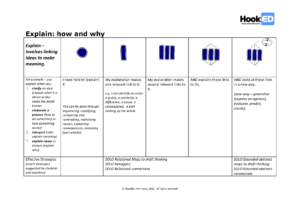Thinking about discourse analysis and the importance of “WHY”
The secondary literacy community has been talking about “why” and where it might fit with SOLO Taxonomy. I’ve tried to play but it seems that my attempts to join in disappear in moderation and my passwords never let me pass. Is easier and quicker to think aloud here.
If you look at discourse analysis in literacy you will see that “WHY” sits squarely at a SOLO relational level of cognitive complexity (representing deep understanding) – this is because “why” requires the students to relate or integrate ideas – make links between ideas to make meaning. In primary schools using SOLO as a model of surface and deep outcomes – “why” (and the discourse markers – “because” “so that”) are used in SOLO highlighting of text to show a relational level outcome
WHY falls under – Informing – explanations
- explain HOW – processes happen (sequential – SOLO relational))
- explain WHY – sequences of causes and effects (causal explanation – SOLO relational))
Explanation represents a logical pattern – e.g. process x occurs, so process y results, which in turn causes process z etc. Students start by identifying the phenomenon to be explained and then follow with the implication sequence that explains it. This interpretation forms an important step in the process of skilled and active critical thinking.
Explanation can involve
- Sequence of events – sequential – [Draft thinking supported by SOLO Sequence map and rubric – relational task]
- Multiple causes for one outcome – factorial – [Draft thinking supported by SOLO Explain causes map and rubric – relational task}
- Multiple outcomes for one cause – consequential – [Draft thinking supported by SOLO Explain effects map and rubric – relational task]
- Multiple conditions and outcomes – conditional – [Draft thinking supported by SOLO “If … then” map and rubric – and SOLO “Explain why in multiple steps” map and rubric developed with Derek Neve at Waimate High School – relational task]
AND each of these is supported with a SOLO Map and self-assessment rubric – so that students can learn the structure of the response at surface and deep levels.
Looking at explanation – you could argue that in some circumstances “explain” encompasses clarification – so you explain when you:
- clarify an idea (explain what it is about or like – make the detail known
- elaborate a process (explain how to do something or how something works)
- interpret (infer – explain meaning)
- explain cause or reason (explain why)
And then because task and outcome can be at different levels with SOLO it is possible to make clear differentiated success criteria for student outcomes when explaining how and why
For more reading around “WHY” and where it sits in SOLO Questioning
Rose, D. (2010) The Routledge Handbook of Discourse Analysis. James Paul Gee and Mike Handford (eds) London: Routledge, 2010
iPad SOLO Question Generator App – https://itunes.apple.com/us/app/question-generator/id989670360
– Teachers and students can use the Question Generator app to learn how to ask the questions that matter most. Using SOLO Taxonomy as a framework, this app generates questions to bring in ideas (to build surface understanding); questions to connect ideas (to develop deep understanding) and questions to extend ideas (to create conceptual understanding). Use the SOLO coded question banks within the app or create your own, either way you will learn how to ask great questions – relevant, appropriate and substantial questions.
Hook, P. (2016). First steps with SOLO Taxonomy. Applying the model in your classroom. Essential Resources Educational Publishers Limited. New Zealand. https://www.essentialresources.co.nz/Store/Product/Detail/5950
PS Exercise great caution when you see SOLO symbols mapped onto other representations – it often pretends to a certainty of alignment that doesn’t exist – and can neglect appropriate attribution e.g. the common mapping of SOLO levels onto the Wiederhold Questioning Matrix (Wiederhold and Kagan 1998)





